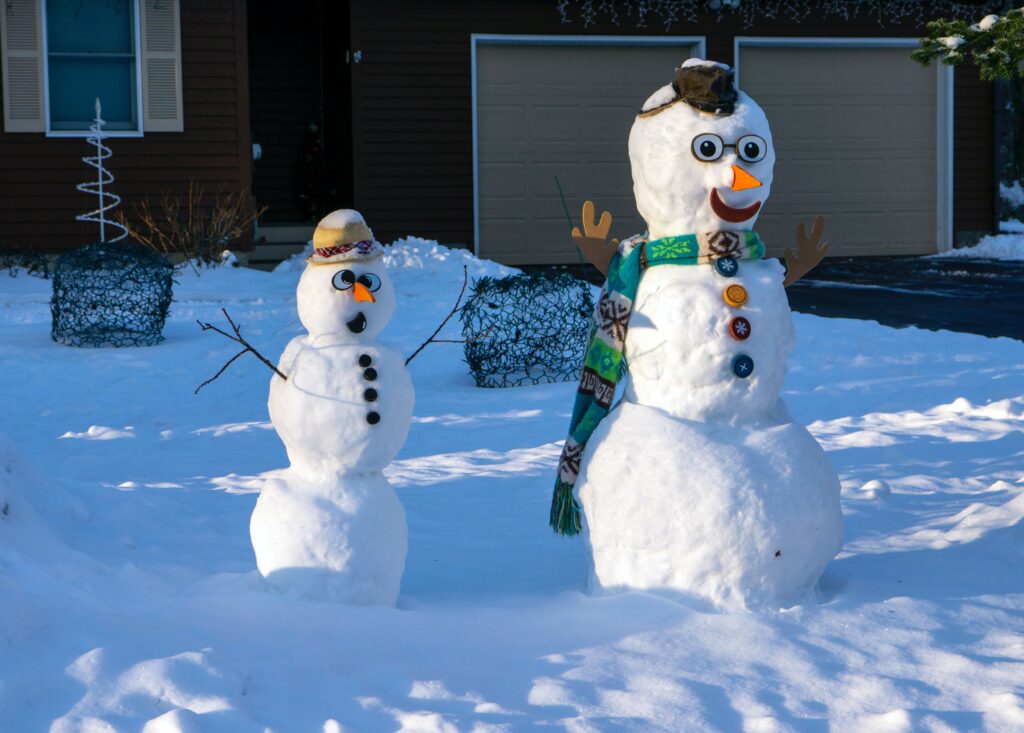Sprinkler Winterization Cost + Free DIY Winterization Checklist

If you live in an area with cold winters, preparing your sprinkler system for the freezing temperatures is essential to avoid catastrophic damage. Allowing water to remain in the pipes and components when it drops below freezing leads to ruptures, leaks, and costly repairs.
Properly winterizing your sprinklers isn’t difficult, but does require following some key steps. In this guide, we’ll cover when you need to winterize based on climate, how to winterize yourself or call in a pro, safety tips, parts needing winterization, freeze prevention, and how to restart the system in spring. Let’s keep your sprinklers protected and ensure they stay ready for next year’s growing season!
When Winterization Becomes Necessary
The point when winterizing becomes critical is when temperatures consistently drop below freezing overnight, usually around 32°F. Liquid water will begin expanding into ice within pipes and valves at this point, leading to cracks and bursts. Let’s look at some temperature thresholds:
– 32°F – Water starts freezing and ice expansion damages components.
– 20°F – Serious risk of catastrophic damage if system not winterized.
– 10°F – Even winterized systems can be damaged at extreme lows.
Once nighttime lows are forecasted to remain below freezing, it’s time to winterize. The temperature of water inside your system can reach freeze points before ambient air temps do if exposed to cold winds.
How Often to Winterize
In regions with sustained sub-freezing winter months, one comprehensive winterization in fall may be sufficient. But in warmer climates with periodic frosts, multiple winterizations may be needed:
– Fall – Complete winterization before deep freezes.
– Mid-winter warm spells – Reactivate system to water, then re-winterize before cold returns.
– Spring – Leave winterized until the last freeze has safely passed.
Monitor long range forecasts and be ready to winterize before cold fronts approach. Pay attention to sudden temperature plunges which can damage unprotected systems still containing liquid water.
Safety Tips for Winterization
– Wear gloves handling icy cold metal and plastic components to avoid frostbite.
– Watch for slippery winter conditions during the process and dress accordingly.
– Never activate a partially winterized system. Frozen blockages can burst pipes.
– In spring, open valves gradually to avoid pressure surges from collected debris.
Work slowly and safely. Rushing through winterization risks missing critical components and invites accidents.
DIY Sprinkler System Winterization
With proper preparation, materials, and time investment, winterization can absolutely be a DIY project:
Supplies Needed:
– Compressor and blowout attachment
– Electrical tape, markers
– Pipe insulation, insulation pipe tape
Steps:
- Shut off main water supply and open drain valves, allowing system to fully depressurize.
- Disconnect and remove sprinkler heads. Use a compressor to blow out lateral pipes completely.
- Drain and disconnect valves, backflow preventer, and shutdown timer. Bring components indoors if possible.
- Remove internal components from any valves left in-ground and drain valve boxes fully using a shop vac.
- Insulate any components that couldn’t be removed or drained using foam covers designed for sprinklers.
- Close main drain valve once water is fully removed. Check periodically for accumulated moisture and repeat sprinkler blowout if needed.
Investing the effort to be extremely thorough prevents freeze damage. Carefully label components for simpler spring reassembly.
Calling in the Pros
Some situations warrant hiring professional winterization services:
– Large/complex systems – Professionals have the specialized equipment and expertise to fully winterize intricate systems.
– Lack proper tools – Services bring high-power commercial compressors and pumps homeowners don’t have for sprinkler blowouts.
– Repeated issues – If you’ve had prior winter damage, hiring pros may be worth the peace of mind.
– Time constraints – Companies can winterize systems much more quickly than DIY.
Even with pro service, familiarize yourself with what winterization entails so you recognize if the work meets quality standards.
Winterizing Key Components
Several components of your sprinkler system need winterization:
– Main valve – Drain completely using bleed or drain screw. Close valve once empty.
– Backflow preventer – Professionals recommend removing and draining the backflow valve before winter. If unable to remove, insulate thoroughly.
– Anti-siphon valves – Remove diaphragms and internal parts, drain fully.
– Zone valves – Remove bonnets, diaphragms and drain all water from valve bodies.
– Isolation valves – Open drain screws to remove water then close valves.
– Sprinkler heads – Remove from supply pipes and store for winter.
Don’t overlook anything – leftover water anywhere can expand and cause freeze damage.
Preventing Winter Damage
For regions with exceptionally frigid winters, extra protection is advised:
– Insulate all components, even drained/disconnected ones. Foam coverings or heat tape both work.
– Support above-ground pipes and valves to bear weight of heavy ice. Avoid straining joints.
– Partially activate only 1 zone at a time on warm winter days ONLY if fully winterized otherwise. Running a partially winterized system can rupture pipes!
– In extremely cold climates, draining may be inadequate. Professional blowouts are highly recommended.
Investing a bit more upfront provides a buffer against freak arctic cold snaps.
Restarting in Spring
When warmer weather returns, you can bring your system out of winter hibernation:
– Inspect components for any freeze damage before reassembling. Make repairs as needed.
– Reinstall valves, heads, and hardware previously removed.
– With main valve closed, turn on water supply to pressurize the line. Open main valve slowly.
– Activate each zone separately and check for broken heads or leaks. Make adjustments.
– Flush out heads thoroughly to remove trapped winter debris from lines.
– Test backflow preventer and valves for proper function before regular spring operation.
– Replace any solenoids that were damaged by water freezing inside them.
The payoff for proper winterization is smoothly firing up your system next season with minimal needed repairs or replacements.
Recommended Winterization Products
Having the right gear makes winterization much simpler:
– Drain valve wrench – Removes drain screw plugs from valves quickly. [$8.99 – Brasscraft]
– Blow out sprinkler adapter – Attaches air compressor to sprinkler lines for winter draining. [$24.99]
– Pipe insulation tape – Insulates any components left exposed over winter.
– Heat cable – Prevents ice buildup on pipes and valves. [$23.99]
– Compression joint repair – For quick fixes to cracked fittings.
– Solenoid Repair Kit – Ensure quick and easy sprinkler valve fixes
Investing in quality winterization tools saves time and prevents headaches year after year.
Choosing Durable Sprinkler Components
Selecting robust, cold-resistant components from the start helps minimize winter damage:
Sprinkler Heads – Look for commercial grade heads made of durable polymers able to withstand freeze/thaw cycles. Choose models with self-draining bases.
Backflow Preventers – Opt for full-port backflow valves which empty more fully when drained. Check for lead-free construction.
Zone Valves – Seek hardy zone valves made with glass-filled polymer housings and stainless steel flow control discs for longevity.
PVC Pipes – Schedule 40 PVC pipe is thicker and more crack-resistant than schedule 20. Dig trenches slightly deeper than code.
The higher initial investment of heavy-duty sprinkler components pays off season after season of reliable operation with minimal winter repairs needed.
Typical Professional Winterization Cost
Typical professional winterization service fees range from $100 – $250:
– Simple system (6 zones or less): $100 – $150
– Medium system (7-12 zones): $150 – $200
– Large/complex system (13+ zones): $200 – $250
Additional services like adding protective pipe insulation, testing backflow preventers, and making minor repairs add cost. DIY winterization can save 50-75% over pro fees.
Safeguarding your sprinkler system from Old Man Winter’s wrath is well worth the time and effort invested. With proper preparation using the right techniques and materials, even novices can master winterization – though some circumstances do warrant calling in the experts. By being diligent and thorough addressing every component, you can rest easy knowing your system will emerge next spring ready for another year of reliable service and nourishing your lawn and gardens.
As an Amazon Associate, we earn from qualifying purchases. Affiliate links help support our work and allow us to continue providing free content. If you make a purchase through an affiliate link, we receive a small percentage of the sale at no extra cost to you.
The DIY repair advice on this site is for informational purposes only. The content aims to be helpful but cannot guarantee success or substitute professional advice. Any repairs involve some risk, so readers assume all liability and responsibility for their actions. Safety should be the top priority. If unsure about any procedure, first consult a qualified professional to determine suitability.
Download Your Free Winter Sprinkler
Maintenance Checklist Now

By sharing your email address you consent to www.mobilesprinklerrepair.com sending you emails occasionally. If you wish to unsubscribe, click the unsubscribe link in the email you receive.
- Sprinkler Rebate Guide
- Slash Your Water Bill and Save the Planet with Sprinkler Rain Sensors!
- How to Revive a Lawn: Bringing Your Drought-Stricken Lawn Back to Life
- Sprinkler Repair Costs: The Shocking Truths You Need to Know!
- Gardeners Won’t Believe These Raised Bed Irrigation System Hacks!
- 11 Shocking Secrets to Buying the Perfect Sprinkler Heads
- A Comprehensive Guide on How to Adjust the Rainbird 5000 Sprinkler Head
- The Complete Step-by-Step Guide to Design a Sprinkler System
- Residential Sprinkler Head Types: A Comprehensive Guide
- Thank You For Subscribing




